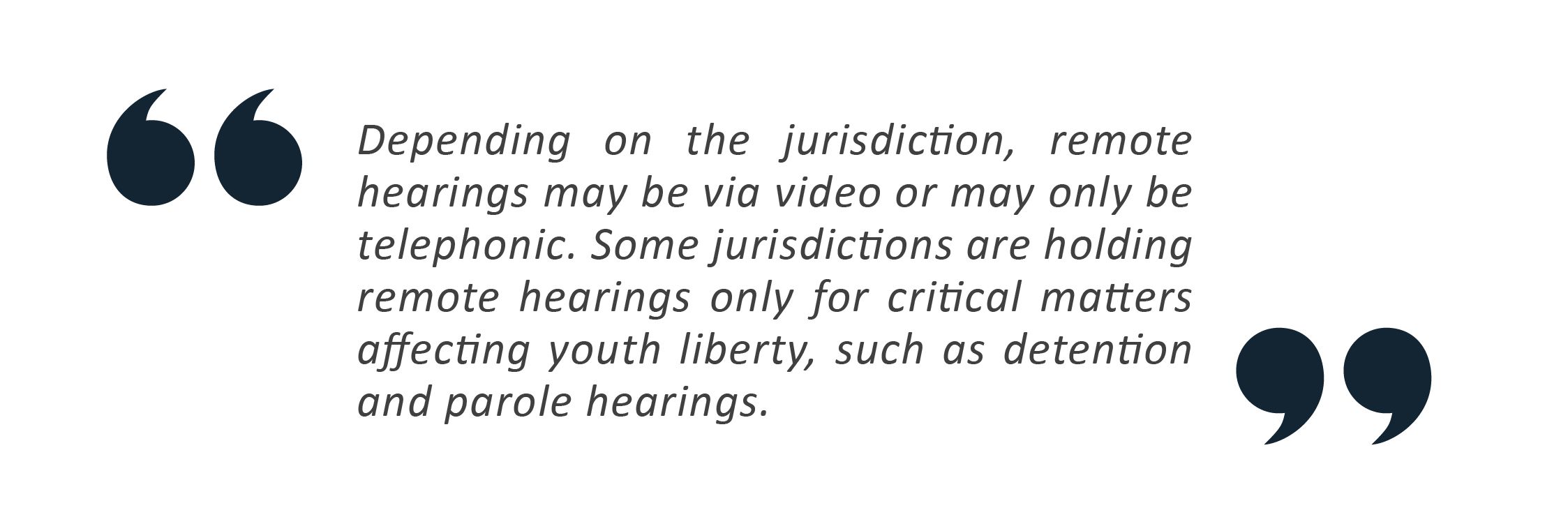
Blog
Remote hearings in the family justice system

Social distancing and community shutdowns are having a deep impact on our nation’s juvenile courts. As a result, many courts have moved to “remote” hearings to handle cases. Depending on the jurisdiction, remote hearings may be via video or may only be telephonic. Some jurisdictions are holding remote hearings only for critical matters affecting youth liberty, such as detention and parole hearings. Other juvenile courts are handling all kinds of hearings remotely.
In efforts to reduce the spread of the virus, governments issued guidance on public interactions that included stay at home orders and closing of many types of businesses. Child welfare court hearings, which have long occurred primarily in person at court houses, had to make changes to practice to ensure safety of professionals and clients alike. Responses to the pandemic varied, including delaying court hearings, moving court hearings to hybrid in-person/virtual formats, and moving to a completely virtual hearing process. Depending on the jurisdiction, remote hearings may be via video or may only be telephonic. Some jurisdictions are holding remote hearings only for critical matters affecting youth liberty, such as detention and parole hearings. Other juvenile courts are handling all kinds of hearings remotely. The boost in court appearances that followed the shift to virtual hearings is consistent with pre-pandemic assertions that reducing the day-to-day costs of coming to court—such as transportation, child care, lost wages, and travel time—would increase people’s ability to meaningfully engage in court cases. We created this checklist of strategies for courts to enable parents and youths to effectively participate in virtual hearings.
Successful strategies to get parents to attend the hearing
Reminders - Calling or emailing parents to remind them about a hearing. Some noted the day before, others the morning of the hearing.
Preparation - Call to inform parents of the virtual process. Explain it to them step by step. Coach them through the process. Let parents know what to expect about the child welfare hearing process (virtual or in-person). Describe the platform and settings prior to the hearing.
Practice - Setup a time to practice on the platform with the parent so that they can experience it prior to the event and troubleshoot any challenges.
Contact day of - Get a phone number for the parent so if they do not show up, the attorney or the court can call them at the time of the hearing.
Flexibility - Allow both phone and video appearances for parents.
Stress importance - Describe the importance of still being present even in a virtual setting.
Documentation/guidance - Create a PDF guide to share on how to access virtual platform.
Meet and participate - Have parents meet with attorneys (or caseworkers) and attend the hearing virtually with them.
Invites - Invitations to the court hearing can include information on how to participate and also court rules).
Time certain calendaring - Set the hearing at a specific time.

Strategies to engage parents in hearings
Introductions - Introduce all participants and explain their role. Introduce the virtual platform, including how to use it and participate in the proceedings. Explain expectations (e.g., when they get to talk, why they will be muted when it is not their turn, etc.).
Explain purpose - Explain to parents the purpose of the child welfare hearing, why they are there and what will happen today.
Greetings - Greet parents by name. Speak directly to them.
Opportunity to be heard - Provide parents an opportunity to be heard. Encourage open discussion in hearings.
Checking-in - Periodically ask if parents have any questions, need a break, or need to speak to their attorney.
Camera use - Encourage to turn on camera so they feel more like they are part of their hearing.
Acknowledge hardship - Acknowledge that virtual may be hard but it is important for them to participate.
Simplify - Use simplified language whenever possible.
Encourage - All professionals can encourage parent’s participation.
Successful strategies to get youth to attend the hearing
Communication - Speak to foster parents, caregivers, child welfare case workers and child advocates to ensure that children and youths who want to be present at a hearing have what they need to do so. Get the link out to the child’s caregiver well in advance of the hearing.
Stress importance - Stress the importance of youth attending the hearing, even virtually. Emphasize that the judge is interested in hearing what they have to say. Advise youth of the value of attendance – that it will assist in achieving their goals.
Reminders - Check in with the youth beforehand to provide a reminder about the hearing. Call ahead of time and remind the youth, foster parent/caregiver about the hearing. Send reminders (via phone, text or email) the day before or the morning of the hearing (or both). Make sure the youth and/or their caregivers have complete access information and re-send that information on the day of the hearing.
Preparation - Explain the purpose of the hearing, what to expect in the hearing, and how the virtual hearing format will work. Provide a step-by-step description of the hearing process, who will be present and what their roles are in the hearing. Go through a list of possible questions that the youth might want to ask (to help them prepare) or the things they might want to share during the hearing. Ask if they have any concerns about the hearing so that the youth can be put at ease.
Practice - Setup a time to practice on the platform with the youth so they can experience it prior to the hearing and troubleshoot any challenges. Coach the youth in the virtual hearing format by doing a test run to get comfortable with the platform, log on procedure, use of breakout rooms and chat features.
Flexibility - Give youth the choice of phone or video conference. Allow the youth to join via phone only if they want. Allow the use of cell phones (e.g., FaceTime) along with computers. Set the hearing at times that facilitate youth attendance (e.g., work around school schedules).
Meet and participate - Have a trusted adult available to attend the hearing virtually with the child/youth.
Provide channel for real-time communication - Have another channel (i.e., text) to communicate with the child in real time during the virtual hearing if needed.
Strategies to engage youth in hearings
Introductions - Introduce all participants and explain their role. Introduce the virtual platform, including how to use it and participate in proceedings. Explain expectations (e.g., when they get to talk, why they will be muted when it is not their turn, etc.).
Explain purpose - Explain to youths the purpose of the hearing, why everyone is present and what will happen today.
Greetings - Greet youths at the beginning of the hearing and by their name. Speak directly to them and tell them their attendance and participation are appreciated. Make sure the youth’s presence is acknowledged, known, and appreciated.
Helping children and youth feel comfortable - Get the youth involved by asking them about school or what they enjoy doing. Use the video view of their environment to talk about what they are doing, any pets or other things around them to make them feel more comfortable. Ask young children an ice-breaker question such as “what is your favorite animal,” and then ask everyone to share what their favorite animal is, as a means to help children to be as comfortable as possible before the hearing begins. Talk about positive achievements.
Hear from children/youth first - Hear from children and youth first (especially young children) when you have their full attention. Hearing from youth at the beginning of the hearing also affords an option for them to exit if there are concerns the hearing might expose the youth to derogatory or negative comments made by parents or relatives.
Opportunity to be heard - Set aside time for private conversations with child and counselor on the line at the beginning of the hearing or at the end. Allow the youth to have their own time to speak and ensure that everyone mutes their mics so youth can have their voices heard without interruption.
Camera use - Ensure children can stay out of sight of the camera if necessary. Allow youth to stop sharing video and participate by phone only if needed. To assist with distraction when the judge is speaking to a child, require all other participants to turn off their cameras unless allowed by the court to speak.

